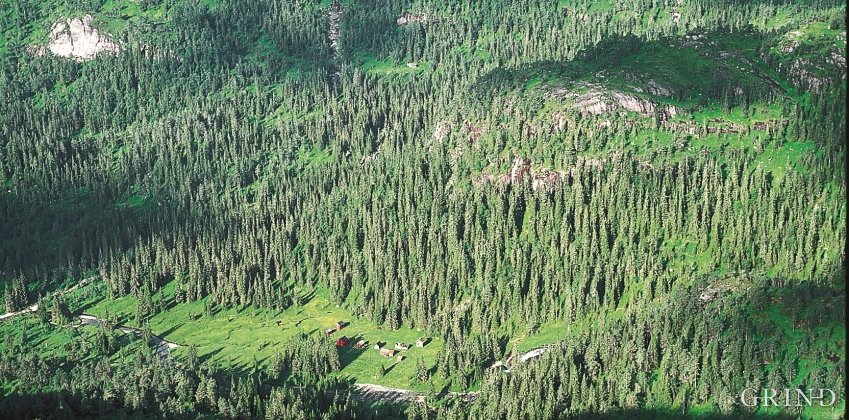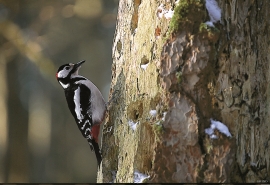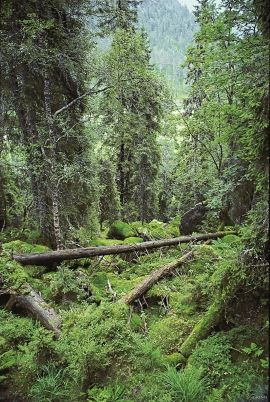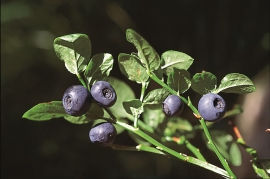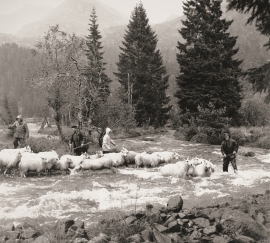Published: 07.08.2015 | Author: Bjørn Moe, Stein Byrkjeland
THE WESTERNMOST NATURAL SPRUCE FOREST IN THE COUNTRY
Otterstadstølen lies in an idyllic grassy plain surrounded by rich forest, but also with high mountains close by. The mountainsides are steep and typical of this part of the county. The same cannot be said about the forest. This spruce forest has been able to develop freely for hundreds of years. Otherwise in the county, only Voss has spruce forest.
The natural spruce forest at Otterstadstølen is rumored to be the most westerly in the country. Sure enough, one finds naturally seeded spruce further west, but these tree colonies are so small that they cannot be considered forests. At Otterstadsølen spruce grows from 200 to 240 mas. There are higher spruce forests, also, usually occurring as slowly growing low trees and bushes. In the steep hills around the summer farms there is dense forest of big trees. Some of them are perhaps as much as 150 years old. Tree windfalls have created openings which give good light and life to the forest floor.
In the spruce forest, one usually finds ferns and heather. Most places one also finds hanging vines, oak fern and blueberry. Large quantities of deer fern and heath fern tell us that the forest belongs to a district with a moist coastal climate. It is not only in western Norway that spruce forest grows under such climatic conditions. We also find a lot of spruce forest all the way out at the coast in parts of Trøndelag. In the Trøndelag spruce forest a number of species of lichen grow, which are closely associated with the coastal spruce forest. Some of them, like the lichen "hraunglompa", for example, grow on thin branches of spruce in the forests of Otterstadstølen. In this area we also find species that are rare in Western Norway, precisely because there is so little natural spruce forest in this part of the country.
Studies of pollen in layers of the earth suggest that spruce migrated into Otterstadstølen less than 400 years ago. Traces of spruce are younger than traces of humans in this mountain farm area. It is therefore tempting to imagine that the forest has given rise to human activity here. Perhaps it was intentional, but it may also have occurred that the mountain farm folk had with them pine cones, and that seeds fell out and planted themselves. At this time there was spruce forest at Voss, and it was probably these that gave rise to the spruce forest at Otterstadstølen.
Woodpeckers
The vast areas of spruce forest in Eastern Norway have a different animal life than we normally find in the planted spruce provinces of Western Norway. In natural spruce forest there are several common traits between Eastern and Western Norway. A good example is the Great Spotted Woodpecker (picture). It is an eastern species that is unusual to find nesting here. But, in the dead and rotten trees at Otterstadstølen, we find numerous traces of the Great Spotted Woodpecker, and probably also others, such as the White-backed Woodpecker and the Grey-headed Woodpecker. We also find the Great Spotted Woodpecker in the natural spruce forest at Voss.
At nesting time the Great Spotted Woodpecker takes a lot of bark- beetles and larvae from the tree stumps. In late autumn and winter, his food is almost solely spruce seeds. In winter, when the spruce seed production fails in Eastern Norway, the Great Spotted Woodpecker comes west in large numbers, in search of better food. If you find "Woodpecker posts" - where the birds have mounted pine cones in order to peck out the seeds - it is proof that the Great Spotted Woodpecker has visited the area.
In contrast to the planted spruce forest, the natural spruce forest is more open. Therefore there is room for more plants to grow on the forest floor, such as ferns and blueberry (picture). (Helge Sunde)
- Farestveit, O. (red.). Bygdebok for Modalen. Bd. II : 17–21. Modalen kommune.
- Fægri, K. 1950. Omkring granens innvandring i Vest-Norge. Naturen 7.
- Moe, D. 1990. Vegetasjonsendringer i Modalen gjennom 10.000 år. I:

